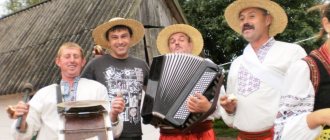Introduction
Mother Volga became excited.
She took away three small boats.
Yes, just like the first one, the carp was carried away,
With sanduks and oak trees
How the second carp was carried away
Let's go with the dresses and the shalkovs
Like the third one, that carp was carried away
You are a red-hearted girl
Shine with Annushka Simyonovnay
And my mother remained
And she shouted loudly:
Warm up, my baby
Yes, please, my dear.
(recorded in the Ulyanovsk region)
The content of my essay was not chosen by chance. Wedding rituals are a very interesting and educational topic.
In my work, I will tell you in sufficient detail about all the intricacies of a Russian wedding, about how matchmaking took place, the bridesmaid ceremony, how the bride and groom prepared for this event, how it was customary to “walk” at the wedding and what happened in the days following the wedding.
I have hardly described modern weddings, since, in my opinion, they are less interesting than ancient ones, although remnants remain, such as bride price or in the last ten years it has become fashionable to get married and this is also a return to tradition. So, let’s now turn to deep antiquity and see how a wedding was played in Rus'.
Modern Russian wedding
The Bride and Groom in Russia meet and decide about the wedding themselves. Sometimes it happens that parents find out about their “children’s” wedding after registration. Most often, however, all possible relatives, as well as friends on VKontakte, etc. know about the wedding in advance. Russians plan the date of marriage registration (this strange word refers to the beginning of life together in Russia) from six months to a month in advance.
During these six months, the bride (grooms often don’t bother much with preparing for the wedding) lives in constant stress. Preparations for a wedding happen both in dreams and in reality. You need to have time to make a list of guests, find a cafe or catering facility for the banquet, figure out where to go for a walk with the photographer after registration, where to get normal shoes, what frills will be on the dress, etc. In this, Russian traditions are not very different from any others. In general, for some brides the pre-wedding six months are a real madhouse.
The bride's wedding dress is traditionally white. Before the time of Catherine, the second bride's outfit in Russia was red. The white dress of the bride, which now symbolizes purity and purity, came from Ancient Greece - there it was a symbol of joy and prosperity. Catherine got married in a white dress and thereby categorically changed Russian tradition.
The wedding day, like in any other country, begins with hair, makeup and dressing. This happens differently for everyone: the bride can do her hair and makeup in a beauty salon with a specially trained hairdresser and makeup artist, or maybe in her own room with improvised tools.
The groom needs less time and effort to prepare.
But sometimes other challenges fall on him (decorating a car, getting a wedding bouquet, and so on).
Meanwhile, the bride continues to be in a commotion. After all, this isn’t just about buying some bouquet (pre-selected by the bride), but you need to arrange your curls correctly, lace up your dress and all that stuff - these are more serious matters.
Parents and girlfriends also participate in the preparation: they rush around the apartment, checking whether all the bottles have been transferred to the cars, whether there are enough sandwiches for the walk, whether everything is ready to meet the groom and whether he has already arrived.
And so, a car pulls up, the groom gets out with a bouquet, and then...the ransom begins. The procedure takes place in the entrance of the bride's house.
Redemption is perhaps the oldest tradition preserved in Russian weddings. Its meaning is fan. The bridesmaids need to torture the groom as cheerfully as possible, ask him a bunch of stupid tasks and riddles and at the same time receive a ransom from him - this could be money or some goodies that he doesn’t mind giving for the bride.
Meanwhile, the bride is finishing her preparations.
If she doesn’t have time, then the groom gets more.
In the end, the groom is allowed into the house, where he still needs to find a bride. Because even here they are trying to deceive him.
In the end, he finds a bride, and everyone drinks champagne on this occasion. Then a moment occurs, the roots of which have been preserved in modern times from antiquity, when the mother handed over the so-called “talisman” to the bride. It could be jewelry or some kind of family heirloom. These talismans were highly valued and were not sold under any circumstances. The bride, in turn, passed them on to her daughter on her wedding day. This sometimes happens at modern weddings too.
Abstract: Wedding traditions
Wedding traditions
Ukrainian wedding is one of the most symbolic celebrations of Slavic culture. There are a great many traditions and customs in the wedding ceremony, which is why weddings in Ukraine lasted a whole week. The guests said: “Friday is the beginning, Saturday is the loaf, Sunday is the wedding, on Monday I eat and drink, on Wednesday I get hungover, and on Thursday after lunch I’ll go home.”
In the pre-Christian period, people got married in early spring, when all living things awakened from winter sleep and strived to procreate. Therefore, this particular period of the year was considered the most favorable time for the formation of a new family. With the advent of Christianity, this tradition changed, since fasting, which fell during this time, prohibited all kinds of amusements and festivities.
A Ukrainian wedding, like any other Slavic one, was preceded by matchmaking. In order not to make a mistake in choosing a bride, it was called “not getting a watermelon,” someone from the future groom’s relatives went to the girl’s parents and tried to find out about the chances of their candidate for marriage.
To woo a girl, the young man went with matchmakers: his father and close relatives - respected married men. For the eldest, as a rule, they chose a “sharp-tongued” and talented man who could artistically deliver a traditional speech about hunters who saw “the trace of a marten - a red maiden” in the snow, etc., because it often depended on his eloquence whether he would leave groom with a “garbuz” or towels.
The girl who was always invited into the house had to stand shyly by the stove. As a sign of consent, she cut the bread brought with the words: “I’m cutting this loaf, and you accept me as your child.” She handed the matchmakers a towel on bread. Accepting the gift, the matchmakers bowed and said: “Thank you also to the girl who got up early, spun finely and wove good towels.” After this, they agreed on viewings (“looking around”) and engagement.
At the screening, the girl’s parents got to know her future relatives better and learned about her wealth. At the engagement, the ritual joining of the hands of the young couple on bread or grain took place. According to popular beliefs, this action had legal force and in some areas was even called a “small wedding.” There is also an assumption that the so-called civil marriage used to exist in Ukraine and was called a trial marriage.
The wedding host and the bride and bridesmaid went separately to invite guests to the wedding. Entering the house, they handed the owners a specially baked figured loaf of bread (“bump”), bowed and said: “Father asked, mother asked, and I ask: come to our wedding!”
Afterwards, the bride and her bridesmaids had a bachelorette party, where they decorated the wedding tree (“conifers”) with ribbons, viburnum and paper flowers.
A Ukrainian wedding always began with the ritual of picking flowers, weaving wreaths and wedding bouquets separately for the bride and groom.
An indispensable attribute of a wedding was a loaf of bread, which was certainly baked by women who were happy in their marriage and were easy on the hand. A loaf is a tall wheat cake decorated with flowers, spikelets, birds, stars and a month made from dough. They symbolized the strength of future married life, happiness, prosperity and harmony.
The wedding began in the hut of each of the young people. When a young man went after a young man, he could be stopped on the way (more than once!), demanding a ransom for the young woman: he had to pay off with a symbolic sum or a treat. The auction continued in the young woman’s yard – the bride’s family also demanded a ransom.
After this, they went to celebrate at the young man’s house. In order to be rich, the young were sprinkled with grain before leaving (now they also add candy - so that life is sweet, and small coins).
After the festive dinner, the young man unbraided his hair. This was done in turn by members of her family, although in some regions the girl’s braid was unraveled by her boyfriend or boyfriends. In the Hutsul region they did not unravel the braid, but cut it off with a hatchet; in Volyn, they cut it off with a knife. From that moment on, the young wife had to hide her head under a scarf.
In Ukraine, folk traditions have long prevailed in wedding ceremonies. Some of them are so ancient that even now it is not easy to find an explanation for them. For example, the tradition of pouring wine and breaking a glass “for good luck” dates back to beliefs in the Sun God (Ra), that is, from pagan times. By pouring out the drink, we subconsciously make a sacrifice to the Sun, and we break the glass, because no mortal dares to use the cup from which the Sun drank.
In the old days, festive festivities continued for several more days. On Monday, guests who came to “get better” were washed by the young woman near the well - the so-called ritual cleansing with water. On these days, only adults walked with games, songs and dressing up. Children and youth did not take part in the post-wedding fun.
According to popular belief, if the wedding takes place on Epiphany (January 19), then the life of the newlywed couple will pass in happiness. Intercession (October 14) is the time for weddings and matchmaking. The girls say: “White snow covers the ground, isn’t it preparing me, young, for marriage?” Or: “Father-Pokrov, cover the earth and me, young one, with cheese!” Whoever marries Kazanskaya (November 5) will be happy.
Much has changed since those ancient times, but many traditions, beliefs and elements of the rituals of our ancestors are integral attributes of our modern wedding.
According to established tradition, the bride and groom must go around the invitees in advance and inform about the upcoming celebration. Nowadays, young people can leave an invitation card or postcard enclosed in an unsealed envelope.
On the eve of registration, the bride and groom visit the registry office to clarify the procedure for the ceremony. They decide for themselves how to carry out the registration: only with witnesses, with the wedding retinue, with the use of ritual symbols, with or without musical accompaniment.
At the appointed time, the groom’s “retinue” arrives to pick up the bride in a car decorated with ribbons and flowers. “Matchmakers” knock, asking for the bride to be given to them. Her friends do not agree, expecting a “ransom”. The matchmaker promises that if they sing the girls' wedding song, and after the song, having presented his girlfriends with flowers and sweets, the groom “receives” the bride, to whom he presents a wedding bouquet.
Sometimes, during the bride price, the groom or his best man is asked to go through a series of comic tests: name as many affectionate words for his beloved as there are matches stuck in an apple; guess on paper the print of the bride’s painted lips among the prints of her friends’ lips, drink a jar of salt water to get the key “to the bride’s heart” from the bottom, etc.
When escorting the newlyweds to the registry office, parents sprinkle them with millet, grain, sweets or coins so that the future spouses can live prosperously. The bride and groom, together with the witnesses - their closest friends and girlfriends, get into the first car: in the back - the groom, the bride and her friend, in front, next to the driver, the witness. He gets out of the car first, opens the door, offers his hand to his girlfriend, after which the groom comes out and offers his hand to the bride. Relatives, matchmakers, and friends follow them on the bus or in cars.
Traditional clothing of newlyweds: the bride’s formal dress is white, as a symbol of the newlywed’s purity. During the second half of the wedding reception, the bride takes off her veil and, according to custom, gives it to one of her unmarried friends. The bride's shoes should be white, soft, and comfortable. Guests are not recommended to wear white attire on their wedding day. The decisive factors when choosing flowers for the bride and the shape of the bouquet are the age and appearance of the bride, as well as the color and length of the wedding dress. For a bride of small stature and fragile build, a small, elegantly arranged bouquet that she can hold with two fingers, or a basket bouquet, is better suited. A tall and appropriately built bride can choose a fairly large bouquet of flowers, which is worn on the crook of her elbow. The wedding is usually celebrated after the marriage. To make the wedding memorable for the newlyweds and guests, it is advisable to combine modern customs with folk traditions.
There are folk signs dedicated to sending young people to church to marry or to the registry office. So, before going to church for the wedding, the bride, who wants her sisters to get married as soon as possible, must pull the tablecloth that covers the table. A pin is pierced into the hem of her dress against the evil eye. A friend selects a pin from a bride’s attire for good luck and a quick marriage.
After registration, according to an established tradition, the wedding cortege goes for a walk, during which they take souvenir photos at local attractions and corners with which “pre-family” memorable events are associated: they met here, they loved to walk here, etc.
Parents come home a little earlier after registering the marriage and greet the newlyweds at the doorstep with bread and salt. Once upon a time this was done by the mother-in-law, into whose house the daughter-in-law was moving to live. Now, if a wedding is celebrated at home, then the mother - the mistress of the house - meets the newlyweds; if there is a grandmother, then she. In the room reserved for the celebration, according to tradition, bread and salt are served by the grandmother or mother of the groom. When she's not there, it's the bride's grandmother. If she is not there, then the mother of the bride or one of the older women.
When performing this ritual, a round loaf of bread with a salt shaker well secured in the middle is placed on a towel. The young pinch off or bite off the bread, dip it in salt and eat. They believe that whoever bites off the most is the owner. This ritual symbolizes true and sincere consent and is a sign that the young will from then on be like crumbs of the same bread.
—> READ COMPLETELY











